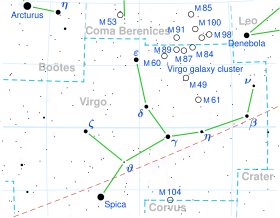| Observation data Epoch J2000.0 Equinox J2000.0 | |
|---|---|
| Constellation | Virgo |
| Right ascension | 12h 41m 53.05658s[1] |
| Declination | +10° 14′ 51.1699″[1] |
| Apparent magnitude (V) | +4.88[2] |
| Characteristics | |
| Spectral type | A0 V[3] |
| U−B color index | +0.03[4] |
| B−V color index | +0.09[4] |
| Astrometry | |
| Radial velocity (Rv) | +1.6[2] km/s |
| Proper motion (μ) | RA: +82.67[1] mas/yr Dec.: –89.08[1] mas/yr |
| Parallax (π) | 27.57 ± 0.21 mas[1] |
| Distance | 118.3 ± 0.9 ly (36.3 ± 0.3 pc) |
| Absolute magnitude (MV) | +1.90±0.28[5] |
| Details | |
| Mass | 2.0[6] M☉ |
| Radius | 1.6[6] R☉ |
| Luminosity | 14[6] L☉ |
| Surface gravity (log g) | 4.36[7] cgs |
| Temperature | 8,930[6] K |
| Metallicity [Fe/H] | –1.00[7] dex |
| Rotational velocity (v sin i) | 154[8] km/s |
| Other designations | |
| Database references | |
| SIMBAD | data |
Rho Virginis (ρ Vir, ρ Virginis) is the Bayer designation for a star in the constellation Virgo. It has an apparent visual magnitude of +4.9,[2] making it a challenge to view with the naked eye from an urban area (according to the Bortle Dark-Sky Scale). The distance to this star has been measured directly using the parallax method, which places it 118.3 light-years (36.3 parsecs) away with a margin of error of about a light year.[1]
Rho Virginis is an A-type main sequence star with a stellar classification of A0 V.[3] It is larger than the Sun with a radius 60%[6] larger and about twice the mass. As such it is generating energy at a higher rate than the Sun, with a luminosity 14[6] times greater. The outer atmosphere has an effective temperature of 8,930 K,[6] which is what gives it the white-hued glow of an A-type star. It is classified as a Delta Scuti type variable star and its brightness varies by 0.02 magnitudes over periods of 0.5 to 2.4 hours.
This star has been established as a Lambda Boötis star that displays low abundances of iron peak elements. It displays an excess of infrared emission, but it is unclear whether this is being caused by a circumstellar debris disk or from the star passing through and heating up a diffuse interstellar dust cloud. Most likely it is the former,[6] in which case the dusty disk has a radius of around 37 AU and a mean temperature of 90 K.[9]
- ^ a b c d e f Cite error: The named reference
aaa474_2_653was invoked but never defined (see the help page). - ^ a b c Cite error: The named reference
scfswas invoked but never defined (see the help page). - ^ a b Cite error: The named reference
aj74_375was invoked but never defined (see the help page). - ^ a b Cite error: The named reference
clpl4_99was invoked but never defined (see the help page). - ^ Cite error: The named reference
Paunzen2002was invoked but never defined (see the help page). - ^ a b c d e f g h Cite error: The named reference
apj694_1_165was invoked but never defined (see the help page). - ^ a b Cite error: The named reference
aaa277_1_139was invoked but never defined (see the help page). - ^ Cite error: The named reference
aaa463_2_671was invoked but never defined (see the help page). - ^ Cite error: The named reference
apj603_2_738was invoked but never defined (see the help page).
